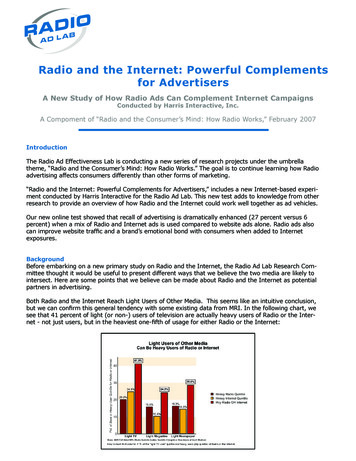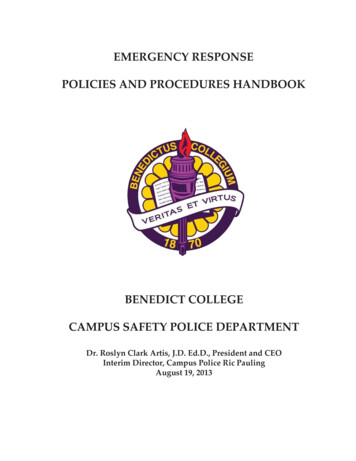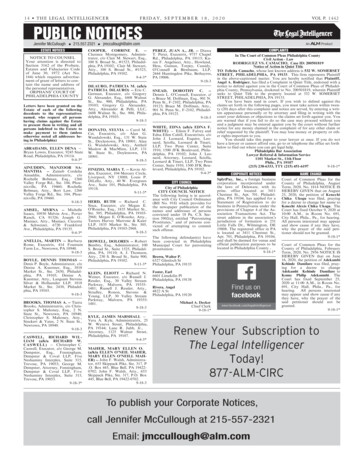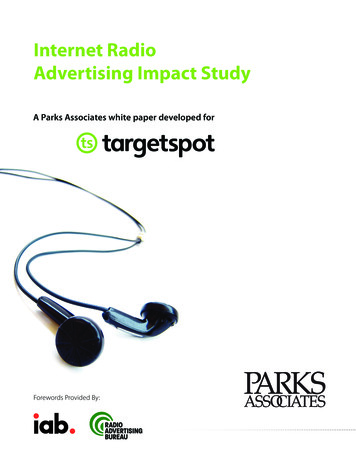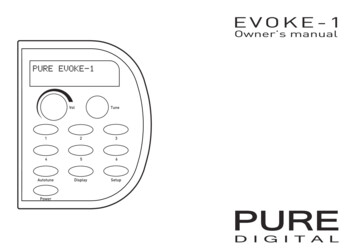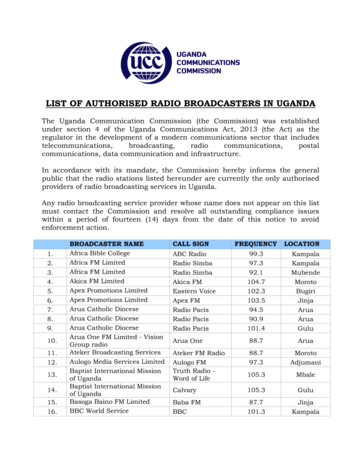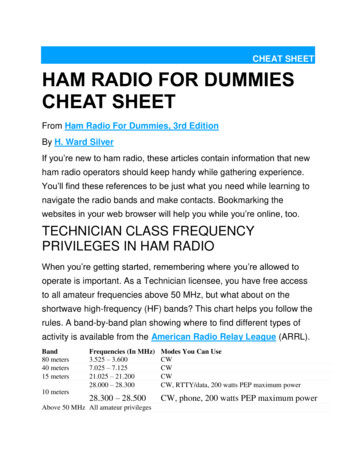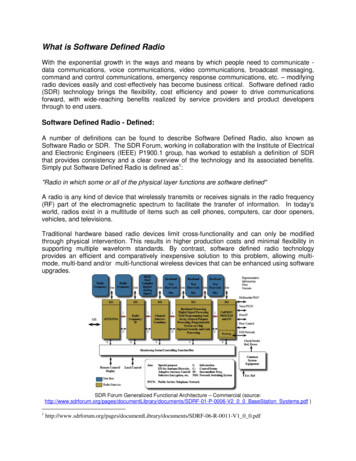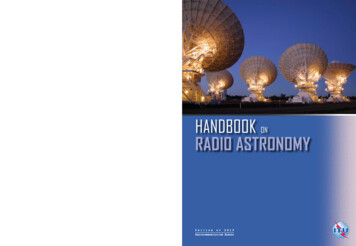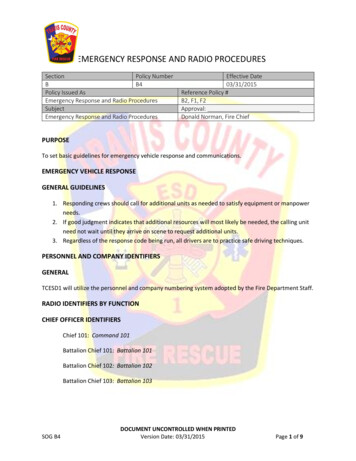
Transcription
Travis County Emergency Services District #1Standard Operating GuidelinesEMERGENCY RESPONSE AND RADIO PROCEDURESSectionPolicy NumberBB4Policy Issued AsEmergency Response and Radio ProceduresSubjectEmergency Response and Radio ProceduresEffective Date03/31/2015Reference Policy #B2, F1, F2Approval:Donald Norman, Fire ChiefPURPOSETo set basic guidelines for emergency vehicle response and communications.EMERGENCY VEHICLE RESPONSEGENERAL GUIDELINES1. Responding crews should call for additional units as needed to satisfy equipment or manpowerneeds.2. If good judgment indicates that additional resources will most likely be needed, the calling unitneed not wait until they arrive on scene to request additional units.3. Regardless of the response code being run, all drivers are to practice safe driving techniques.PERSONNEL AND COMPANY IDENTIFIERSGENERALTCESD1 will utilize the personnel and company numbering system adopted by the Fire Department Staff.RADIO IDENTIFIERS BY FUNCTIONCHIEF OFFICER IDENTIFIERSChief 101: Command 101Battalion Chief 101: Battalion 101Battalion Chief 102: Battalion 102Battalion Chief 103: Battalion 103SOG B4DOCUMENT UNCONTROLLED WHEN PRINTEDVersion Date: 03/31/2015Page 1 of 9
Travis County Emergency Services District #1Standard Operating GuidelinesEMERGENCY RESPONSE AND RADIO PROCEDURESSTAFF OFFICERSafety Officer 101: Safety 101INDIVIDUAL CREW MEMBER IDENTIFIERSCrew members are identified by the apparatus and by location and assignment.Quint 101 Officer in Front Passenger Seat: Quint 101 OfficerQuint 101 Driver/Operator: Quint 101 DriverRemaining firefighters are identified by last name, with applicable rank first:Quint 101 LT Smith seated in rear: Quint 101 LT SmithQuint 101 FF Jones seated in rear: Quint 101 FF JonesIf only one FF is assigned to a Quint:Quint 101 FF Jones: Quint 101 FFTERMINOLOGYGENERALTCESD1 will utilize the radio terminology adopted by the Fire Department Staff.PLAIN ENGLISH/CLEAR TEXT (NO SCREAMING STAY CALM)Radio codes and signal codes will not be utilized. “Plain English” or “Clear Text” terminology will beutilized.MILITARY/MEDICAL TIMEThe military or medical 24 hour time system will be utilized in TCESD1 Communications.“HEY YOU, IT’S ME”First state who you are calling, then identify yourself. “Fire dispatch, this is Quint 101 .”SOG B4DOCUMENT UNCONTROLLED WHEN PRINTEDVersion Date: 03/31/2015Page 2 of 9
Travis County Emergency Services District #1Standard Operating GuidelinesEMERGENCY RESPONSE AND RADIO PROCEDURESRADIO TERMINOLOGYThe use of standard words and phrases contribute significantly to the conservation of airtime. Theyare short, easily understood, and convey concise meaningful information. Use the words and phrasesas stated. Do not abbreviate or ad-lib, and when communicating with outside agencies use thestandard phraseology, when applicable.TERMS AND DEFINITIONSTERMAmbulanceMEANINGA ground vehicle providing patient transport capability,specified equipment capability, and personnel (basic lifesupport ambulance or advanced life support ambulance,etc.)“BENCH MARKS”BRUSHBroadcast by Command only.A light, mobile vehicle, having limited pumping and watercapacity – used for off-road operations.CODE BLUEHOT ZONEPolice needed immediately. HOSTAGE SITUATIONArea immediately surrounding a dangerous goods incident,which extends far enough to prevent adverse effect fromreleased dangerous goods to personnel outside the zone.This zone is also referred to as exclusion zone or restrictedzone.D.O.S.COMMANDCOMMAND POST (CP)Deceased On Scene.Assigned to person in charge at any incident.That location at which primary command functions areexecuted. The Command Post is usually located with theIncident Base.COMMANDER (BYFUNCTION)Supervises and coordinates the resources assigned tostaging area, resource area, rehab area, etc.INCIDENT COMMANDER(IC)The individual responsible for the management of allincident operations.SAFETY OFFICERMember of the Command Staff responsible for monitoringand assessing safety hazards, unsafe situations, anddeveloping measures for ensuring personnel safety.J.P.T.C.S.O.DISPATCHJUSTICE OF PEACETravis County Sheriff's OfficeA facility from which resources are directly assigned to anincident.SOG B4DOCUMENT UNCONTROLLED WHEN PRINTEDVersion Date: 03/31/2015Page 3 of 9
Travis County Emergency Services District #1Standard Operating GuidelinesEMERGENCY RESPONSE AND RADIO PROCEDURESCODE 1CODE 3TACH/TACH CHANNELEN ROUTERECEIVEDResponse with no lights or siren.Response using lights and sirens.Tactical Channel (ex. 201, 202, 203)Used to confirm response.Used to acknowledge a clear understanding of radiocommunications."xxxxx DIRECT"Used to acknowledge a clear understanding of a radiocommunication directed to more than one apparatus.Example with more than one unit responding: Commandstates "all responding units can reduce code". Quint 101responds "Quint 101 Direct".REPEAT YOUR MESSAGEAVAILABLEUsed when radio message is broken or garbled.Used to report status. Able to respond to an emergency call.CLEAR AVAILABLEUNAVAILABLEREDUCE CODE ANDCONTINUETerm used to clear apparatus from an incidentApparatus that is already on assignment or out of service.Continue on code 1 to the incident.CANCELOrder given to incoming equipment at means that they mayreturn to a non-emergency status.ON SCENEUNDER CONTROLAFFIRMATIVENEGATIVEEMERGENCY TRAFFICUsed to check out on the location of an incident.Signals the progress of an incident has been stabilized.Used to signal "Yes".Used to signal “NO”.This statement is made when everyone needs to clear thechannel for a communication that is of the utmostimportance. When this is heard you must hold all radiotraffic until the emergency is resolved.MAYDAYUsed by firefighters to report their status as in need ofrescue.ETALOUD & CLEAREstimated time of arrival per unit or agency.Used to acknowledge clear radio transmission during a radiocheck.SOG B4DOCUMENT UNCONTROLLED WHEN PRINTEDVersion Date: 03/31/2015Page 4 of 9
Travis County Emergency Services District #1Standard Operating GuidelinesEMERGENCY RESPONSE AND RADIO PROCEDURES"MOVING UP"OFFENSE TO DEFENSEUsed when a unit is relocating to cover an empty stationThe transition in fire attack from the interior of a structureto the exterior.“Evacuate Building”The announcement of a change to a defensive mode will bemade as “Emergency Traffic” and the benchmark will betransmitted and noted within the dispatch record.HAZARD ZONEThe area of maximum hazard. For a structure fire, thehazard zone is the structure itself, the collapse perimeter,and any area exposed to the fire or products of combustion.Access to the hazard zone shall be restricted to essentialpersonnel who are wearing equipment suitable for thehazards, which may be encountered. Company integrity isrequired within the hazard zone.HAZARDOUS LOCATIONAn unsafe envrionment. A person on the scene has someform of communicable disease and/or there is an elevatedrisk of violence and/or weapons on scene, etc.HAZ-MATPRIMARY SEARCHHazardous materialAn unsafe envrionment. A person on the scene has someform of communicable disease and/or there is an elevatedrisk of violence and/or weapons on scene, etc.SECONDARY SEARCHALL CLEARLAY A LINE2ndSearch that is done after the fire is under control.Benchmark declaring completion of the Primary Search.Pull hose off of the apparatus, usually refers to establishinga water supply line from a fire hydrant to the attackingcompany.MED COMMOrganization that provides communications for medicalcalls. Primary channel for TCESD1 is Med Comm West(MCOMW)MUTUAL AIDEstablished plan of assistance with surroundingdepartments.MVAMotor vehicle accident.SOG B4DOCUMENT UNCONTROLLED WHEN PRINTEDVersion Date: 03/31/2015Page 5 of 9
Travis County Emergency Services District #1Standard Operating GuidelinesEMERGENCY RESPONSE AND RADIO PROCEDURESPERSONNELACCOUNTABILITY REPORT(PAR)Benchmark requiring a Roll Call of personnel operating inthe Hazard Zone.PUBLICSERVICE AT#QUICK ATTACKQUINTUse to inform unit of need to telephone. Give name andtelephone #.REHABILITATIONS(REHAB)That function and location that includes medical evaluationand treatment, food and fluid replenishment, and relieffrom extreme climatic conditions for emergency personnel.Rehab operations are established according to thecircumstances of the incident and are designed to mitigateagainst the physical, physiological, and emotional stress offire fighting in order to sustain a member’s energy, improveperformance, and decrease the likelihood of on-scene injuryor death.RESCUEA ground vehicle providing specified rescue equipment,capability and personnel.RIC TEAMA team of two or more fighterfighters dedicated solely tothe search and rescue of other firefighters in distress.SECTORThat organizational level having functional responsibility forprimary segments of incident operations such asGeographical Area, Operations, Logistics, andFinance/Administration. The Section level is organizationallybetween Branch and Incident Commander.SIZEUPBrief description of an incident, given when a fire apparatusfirst arrives on a scene."CAN" ReportA progress report listing Conditions, Actions, and Needs.SOG B4DOCUMENT UNCONTROLLED WHEN PRINTEDVersion Date: 03/31/2015To make an initial attack on a fire with existing resources.Fire apparatus with a permanently mounted fire pump, awater tank, a hose storage area, an aerial ladder or elevatingplatform with a permanently mounted waterway, and acomplement of ground ladders and personnel.Page 6 of 9
Travis County Emergency Services District #1Standard Operating GuidelinesEMERGENCY RESPONSE AND RADIO PROCEDURESSPECIALTY TEAMA grouping of resources with either an exterior geographic orfunctional assignment.STAGED ATSTAGINGUnit is standing by at a designated location.Used for large, complex, or lengthy operations. Additionalresources are staged together in a specific location under aStaging Officer.STAGING AREAThat location where individual personnel and equipment areassigned on an immediately available basis.STANDBYTERMINATING INCIDENT/TERMINATING COMMANDUsed when necessary for radio caller to stop and wait.Used by the last unit to leave an incident. It signifies to ARP andother companies, there are no units remaining on scene and shallbe noted within the dispatch record.VENTILATETo open a structure in such a way that heat and smoke can beremoved.COLD ZONEArea where the Command Post (CP) and support functions thatare necessary to control the incident are located. This is alsorefereed to as the Clean Zone.WARM ZONEArea where personnel and equipment decontamination and hotzone support take place. It includes control points for the accesscorridor and thus assists in reducing the spread of contamination.Also referred to as the decontamination, contaminationreduction, or limited access zone.“WORKING FIRE”Indicates a situation which will require the commitment of allresponding companiesEXAMPLES OF TERMINOLOGY USE1. ENROUTE - This term denotes that a piece of apparatus is going to a certain location on a Fireor Med response.Ex: Dispatch, Quint 101 (wait for dispatch response), show Quint 101 ENROUTE to 125 MainStreet2. ON SCENE - Term used to check out on the location of an incident or hospital. This is a part ofour standard checkout sequence. (Address, hydrant, location)On Scene sequence goes like this:SOG B4DOCUMENT UNCONTROLLED WHEN PRINTEDVersion Date: 03/31/2015Page 7 of 9
Travis County Emergency Services District #1Standard Operating GuidelinesEMERGENCY RESPONSE AND RADIO PROCEDURESa) Apparatus I.D. (apparatus then number, Ex. Quint 101)b) On Scenec) Addressd) Descriptione) Conditionsf) Action taken if applicableEx: Dispatch from Quint 101, we are ON Scene with nothing showing. Quint 101 will bein investigation mode. (Fire call)Ex: Dispatch from Quint 101 we are On Scene - We have two cars involved withmoderate damage (traffic accident).Note that if Quint 101 is first on scene, an action will also be to assume command.Reference SOGs Command Procedures and Tactical Guidelines for detailed guidance.3. AVAILABLE - Term used to clear apparatus from an incident.AVAILABLE sequence:a) Apparatus I.D.b) AVAILABLEc) From what locationEx: Dispatch from Quint 101 - AVAILABLE from 885 Ovilla Rd.4. EMERGENCY TRAFFIC - whoever broadcasts this message, owns the air.Emergency Traffic sequence:a) I.D. (Apparatus, Command, Person)b) Emergency trafficc) State messageALL UNITS HOLD MESSAGES FOR EMERGENCY BROADCAST5. ALL CLEAR - Term used at the end of the primary search. All clear is broadcast to all units.Primary search determines that there are no victims and a safe attack can be made.Ex: Command from Division 1 - All clear on primary searchEx: Dispatch from Command: All clear on primary searchSOG B4DOCUMENT UNCONTROLLED WHEN PRINTEDVersion Date: 03/31/2015Page 8 of 9
Travis County Emergency Services District #1Standard Operating GuidelinesEMERGENCY RESPONSE AND RADIO PROCEDURES6. ICS setup dictates that LOCATION is COMMAND.Ex: Bluebird COMMANDAlways set up command and terminate command. Command is passed face-to-face inmost instances.7. OUT OF SERVICE - This term denotes when a piece of apparatus goes out of service for areason.Out of Service sequence goes like this:a) Apparatus I.D.b) Out of servicec) Reason - mechanical, manpower, waterFor detailed information, see SOGs: RIC/Rescue Command Responsibilities Command Procedures Tactical Guidelines May-DayEmergency Driving Driving Policy Structural FiresSOG Revision RecordVersion Number1SOG B4DateReason for Revision03/31/2015 Document ReleaseDOCUMENT UNCONTROLLED WHEN PRINTEDVersion Date: 03/31/2015Page 9 of 9
Travis County Emergency Services District #1 Standard Operating Guidelines a) Apparatus I.D. (apparatus then number, Ex. Quint 101) b) On Scene c) Address d) Description e) Conditions f) Action taken if applicable Ex: Dispatch from Quint 101, we are ON Scene with nothing showing. Quint 101 will be in investigation mode. (Fire call)
